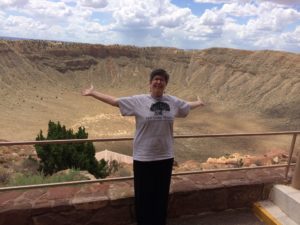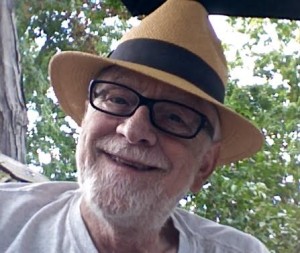By Robert Thomas
That’s My Moon Over Court Street: Dispatches from a life in Flint is an intimate time capsule of a life in Flint composed of Jan Worth-Nelson’s collected columns from East Village Magazine, 2007- 2022.
“My adult life in Flint,” she writes in her Introduction, “has had some dark times, and I haven’t
been spared from hard and stupid things. These essays describe the improbable happiness I have
found so often here. How could that happen in a town like this, even through some of its toughest times? These columns, one by one, represent a kind of answer, the vindication of claiming my life in this complicated city: to look at it, to love it, sometimes to despair about it, and to write it into the cornucopia of our collective human lives.”
In the first column, March 2007, “I never thought I’d stay this long,” the author pursues further questions about her life in Flint. “What does it mean,” she ponders, “to live in a place for a very long time? What does it mean, particularly, to live in a place for a very long time that is, say, bleak, unglamorous, and at its best, notorious? What does it mean, in other words, to live for a very long time in Flint?”
Worth-Nelson wraps up her questions by asserting that “when Gary Custer [founder and late publisher of EVM] asked if I’d like to write this column for a while, I realized I might have a lot to say about this old town.” And so she does, as exhibited by these “Village Life “columns.
I reveled in the authentic conversational voicing of a gifted storyteller who writes vividly. I came to see her book as a collection of storied vignettes which proclaim that Flint’s story is the story of the people. This collection resonates with wit, humor, and innate humanity. It is humanity that weaves together Worth-Nelson’s reflections.
With “Bulldozing Flint is premature” for example, she responds to bloviator Russ Limbaugh’s call to “just bulldoze Flint” with a tale of neighborliness that concludes: “In the meantime, neighborhood life in all its lovely variety continues, the balm for discontent.”
Discontent and balm salt and pepper the pages of these columns from “Can there be happy
darkness,” “Thinking about escape from Flint,” and “Life is unendingly fragile” to “Surviving with wrath and yoga,“ “When you need to turn to art,” and “A reclaimed piano reclaims grace in a time of plague.”
Righteous anger and art rock and roll the wavy flow of these columns. The Flintoids Worth-Nelson profiles in her columns add herbs and spices to her Flint pot. What’s a story without colorful characters, heh? Flint supplies the goods, as the author demonstrates. The 2015 and 2016 columns are particularly visceral as the columns reflect on wrath in light of the complete failure of government at every level. I was taken with the author’s passionate consternation and indignation.
“Flint’s botched water crisis: betraying the Common Good,” “Can water be made holy again?”
and “Primal scream, anyone? ‘The Most (Blank) City in America,’” and “It’s gotten hard to write
about nuthatches” offer primal insights into a Flintoid’s PTSD after being poisoned by policy.
Worth-Nelson resolves these reflections in “Buckle up for the pursuit of truth,” which opens with
the First Amendment of the Constitution honoring free speech and closes with the author’s challenge: “Buckle up. I’m ready to fight.”

Jan Worth-Nelson jubilantly turning her back on the abyss and celebrating that we’re still alive. In this case, Meteor Crater, Arizona (Photo by Ted Nelson)
In “There’s no avoiding family life this season,” the column delves into the essence of true
families. “We can make our own families,” she asserts. And we Flintoids do, as she accurately
reports. In “Flint moves beyond ghosts as autumn whispers in,” the author ponders, “how does a person move on? How does a community battered by trouble move on? It’s not like this is a new
question—it’s THE Flint conundrum, the reality of Flint that continually makes us both a
cautionary tale and also—Lordy, could we pull this off?—a template of recovery.”
In “Remembering a Flint walk when I’m far away,” Worth-Nelson opines that “We Flint people
know what it feels like when the promise, the delusions of ‘progress,’ crash and burn. We also
know that after the crash, sometimes there might be beauty to be reclaimed, peace in the quiet
after the purveyors of greed go away. A lot of us are damaged in the ruins, but that doesn’t mean
we’re not still capable—we can still see a carpet of red and gold in somebody’s unraked yard, for
example, and passionately love it.”
“Neighborly life can be full of grace” fittingly concludes this collection. “Regardless of what I
understood about life when I got to Flint in 1981,” writes the author, “there is nothing richer or
more affirming than the love and generosity of good neighbors, of relationships steeped in shared
history and nurtured in understanding. This is what I know now about what matters in life—and
what Flint has given. So when I die, I think there will be no bitterness: I lucked out when I
landed in Flint.”
Upon pondering, That’s My Moon Over Court Street reminded of a quote from George Orwell’s
essay “Why I Write” :
“When I sit down to write a book, I do not say to
myself that I am going to produce a work of art.
I write because there is some lie that I want to expose,
some fact to which I want to draw attention,
and my initial concern is to get a hearing.”
Jan Worth-Nelson gets her hearing with this collection of her reflections.
“I know, I know,” she asserts in “Flint moves beyond ghosts as autumn whispers in,” “just
watching isn’t enough. But it’s something to be good at: paying attention, after all, is a serious
calling.”
That’s My Moon Over Court Street: Dispatches from a life in Flint is available on Amazon.com and locally at the Sloan Museum and Totem Books, located at 620 W. Court Street, Flint 48503.

Robert Thomas
Reviewer Robert R. Thomas is a former EVM board member, passionately devoted denizen of East Village, and a former San Francisco cable car driver.


You must be logged in to post a comment.